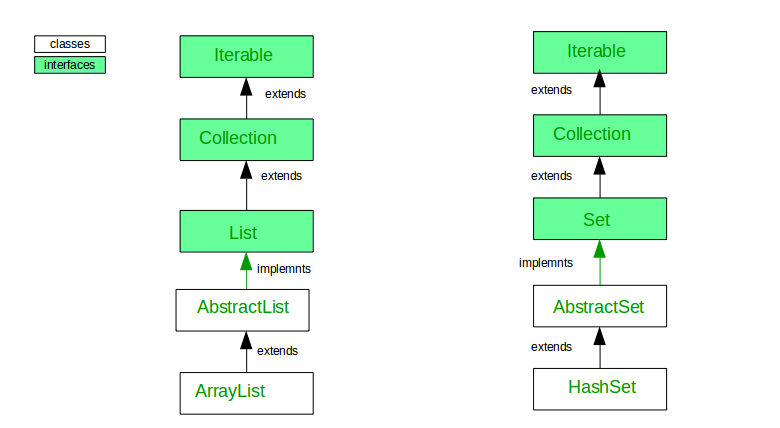Difference between ArrayList and HashSet in Java
Last Updated :
08 May, 2023
Here are couple of differences between ArrayList and HashSet.
- Inheritance:

- Implementation: Implementation : ArrayList implements List interface while HashSet implements Set interface in Java.
- Internal implementation: ArrayList is backed by an Array while HashSet is backed by an HashMap.
- Duplicates : ArrayList allows duplicate values while HashSet doesn’t allow duplicates values.
- Constructor : ArrayList have three constructor which are ArrayList(), ArrayList(int capacity) ArrayList(int Collection c) while HashSet have four constructor which are HashSet(), HashSet(int capacity), HashSet(Collection c) and HashSet(int capacity, float loadFactor)
- Ordering : ArrayList maintains the order of the object in which they are inserted while HashSet is an unordered collection and doesn’t maintain any order.
- Indexing : ArrayList is index based we can retrieve object by calling get(index) method or remove objects by calling remove(index) method while HashSet is completely object based. HashSet also does not provide get() method.
- Null Object: ArrayList not apply any restriction, we can add any number of null value while HashSet allow one null value.
9. Basic Operation’s Time complexity :-
9.1 ArrayList common operation’s time complexity
add() – takes O(1) time;
get() – it takes constant time O(1);
remove() –it takes linear time complexity O(n) . It iterate the entire array to find the element qualifying for removal.
contains() – It also take linear time complexity O(n).
9.2 Set common operation’s time complexity
For HashSet, the add(), remove() and contains() operations cost constant O(1) time thanks to the internal HashMap implementation.
- Syntax: ArrayList:-
ArrayList list=new ArrayList();
- HashSet:-
HashSet set=new HashSet();
ArrayList example
JAVA
import java.io.*;
import java.util.*;
class ArrayListTest {
public static void main(String[] args)
throws IOException
{
int n = 5;
List<Integer> al = new ArrayList<>(n);
for (int i = 1; i <= n; i++) {
al.add(i);
}
System.out.println(al);
al.remove(3);
System.out.println(al);
for (int i = 0; i < al.size(); i++) {
System.out.print(al.get(i) + " ");
}
}
}
|
Output:
[1, 2, 3, 4, 5]
[1, 2, 3, 5]
1 2 3 5
HashSet example
JAVA
import java.util.HashSet;
import java.util.Set;
class HashSetDemo {
public static void main(String[] args)
{
Set<Integer> hs = new HashSet<>();
hs.add(1);
hs.add(2);
hs.add(3);
hs.add(4);
hs.add(4);
for (Integer temp : hs) {
System.out.print(temp + " ");
}
}
}
|
Output:
1 2 3 4
Like Article
Suggest improvement
Share your thoughts in the comments
Please Login to comment...